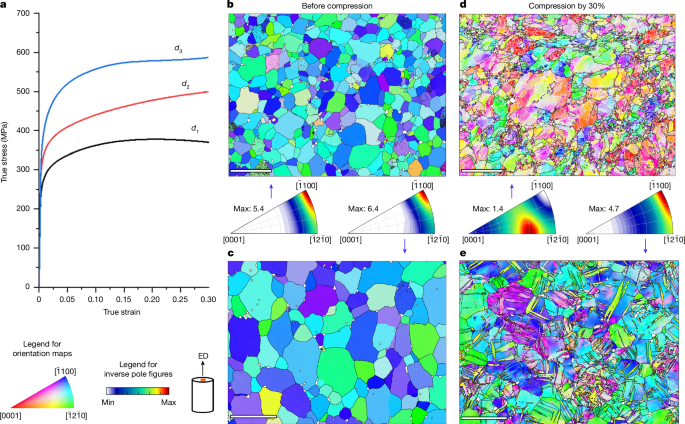Drelich, A. J., Zhao, S., Guillory, R. J. II, Drelich, J. W. & Goldman, J. Long-term surveillance of zinc implant in murine artery: surprisingly steady biocorrosion rate. Acta Biomater. 58, 539–549 (2017).
Yang, H. et al. Evolution of the degradation mechanism of pure zinc stent in the one-year study of rabbit abdominal aorta model. Biomaterials 145, 92–105 (2017).
Han, H.-S. et al. Current status and outlook on the clinical translation of biodegradable metals. Mater. Today 23, 57–71 (2019).
Li, C. et al. Design of biodegradable, implantable devices towards clinical translation. Nat. Rev. Mater. 5, 61–81 (2020).
Yang, H. et al. Alloying design of biodegradable zinc as promising bone implants for load-bearing applications. Nat. Commun. 11, 401 (2020).
Zhu, S., Wu, C., Li, G., Zheng, Y. & Nie, J.-F. Microstructure, mechanical properties and creep behaviour of extruded Zn-xLi (x = 0.1, 0.3 and 0.4) alloys for biodegradable vascular stent applications. Mater. Sci. Eng. A 777, 139082 (2020).
Barnett, M. R. Twinning and the ductility of magnesium alloys: Part I: “Tension” twins. Mater. Sci. Eng. A 464, 1–7 (2007).
Nie, J. F., Shin, K. S. & Zeng, Z. R. Microstructure, deformation, and property of wrought magnesium alloys. Metall. Mater. Trans. A 51A, 6045–6109 (2020).
Windhagen, H. et al. Biodegradable magnesium-based screw clinically equivalent to titanium screw in hallux valgus surgery: short term results of the first prospective, randomized, controlled clinical pilot study. Biomed. Eng. Online 12, 62 (2013).
Kacarevic, Z. P. et al. Biodegradable magnesium fixation screw for barrier membranes used in guided bone regeneration. Bioact. Mater. 14, 15–30 (2022).
Qiao, W. et al. Divalent metal cations stimulate skeleton interoception for new bone formation in mouse injury models. Nat. Commun. 13, 535 (2022).
Li, H. F. et al. Development of biodegradable Zn-1X binary alloys with nutrient alloying elements Mg, Ca and Sr. Sci. Rep. 5, 10719 (2015).
Shi, Z.-Z. et al. Effects of Ag, Cu or Ca addition on microstructure and comprehensive properties of biodegradable Zn-0.8Mn alloy. Mater. Sci. Eng. C 99, 969–978 (2019).
Yip, S. The strongest size. Nature 391, 532–533 (1998).
Koike, J., Sato, Y. & Ando, D. Origin of the anomalous \(\{101\bar{2}\}\) twinning during tensile deformation of Mg alloy sheet. Mater. Trans. 49, 2792–2800 (2008).
Suh, B.-C., Shim, M.-S., Kim, D.-W. & Kim, N. J. Twinning behavior of Mg–4Zn–1Gd alloy sheet during longitudinal tensile deformation. Scr. Mater. 69, 465–468 (2013).
Christian, J. W. & Mahajan, S. Deformation twinning. Prog. Mater. Sci. 39, 1–157 (1995).
Marek, R. et al. Degradation behavior and osseointegration of Mg–Zn–Ca screws in different bone regions of growing sheep: a pilot study. Regen. Biomater. 10, rbac077 (2023).
Tromans, D. Elastic anisotropy of hcp metal crystals and polycrystals. Int. J. Res. Rev. Appl. Sci. 6, 462–483 (2011).
Liu, H. et al. Variant selection of primary-secondary extension twin pairs in magnesium: an analytical calculation study. Acta Mater. 219, 117221 (2021).
Yang, H. et al. Zn-0.4Li alloy shows great potential for the fixation and healing of bone fractures at load-bearing sites. Chem. Eng. J. 417, 129317 (2021).
Xiao, X. et al. Investigation of zinc-silver alloys as biodegradable metals for orthopedic applications. J. Mater. Res. Technol. 26, 6287–6303 (2023).
Diekmann, J. et al. Examination of a biodegradable magnesium screw for the reconstruction of the anterior cruciate ligament: a pilot in vivo study in rabbits. Mater. Sci. Eng. C 59, 1100–1109 (2016).
Martinez, D. C. et al. Bone cells influence the degradation interface of pure Mg and WE43 materials: Insights from multimodal in vitro analysis. Acta Biomater. 187, 471–490 (2024).
Lee, J.-W. et al. Long-term clinical study and multiscale analysis of in vivo biodegradation mechanism of Mg alloy. Proc. Natl Acad. Sci. USA 113, 716–721 (2016).
Cha, P.-R. et al. Biodegradability engineering of biodegradable Mg alloys: Tailoring the electrochemical properties and microstructure of constituent phases. Sci. Rep. 3, 2367 (2013).
Okutan, B. et al. The combined effect of zinc and calcium on the biodegradation of ultrahigh-purity magnesium implants. Biomater. Adv. 146, 213287 (2023).
Trumbo, P., Yates, A. A., Schlicker, S. & Poos, M. Dietary reference intakes. J. Am. Diet. Assoc. 101, 294–301 (2001).
Wang, J. et al. Recommendation for modifying current cytotoxicity testing standards for biodegradable magnesium-based materials. Acta Biomater. 21, 237–249 (2015).
Kubásek, J., Dvorský, D., Čavojský, M., Roudnická, M. & Vojtěch, A. WE43 magnesium alloy – material for challenging applications. Metall. Mater. 57, 159–165 (2019).
Tolnai, D., et al. In situ synchrotron radiation study of the tension–compression asymmetry in an extruded Mg–2Y–1Zn–1Mn alloy. In Proc. Magnesium Technology 2022 (Maier, P. et al., eds), 143–148 (Springer, 2022).
Li, H. et al. Design and characterizations of novel biodegradable ternary Zn-based alloys with IIA nutrient alloying elements Mg, Ca and Sr. Mater. Des. 83, 95–102 (2015).
Pinc, J. et al. Microstructure evolution and mechanical performance of ternary Zn-0.8Mg-0.2Sr (wt. %) alloy processed by equal-channel angular pressing. Mater. Sci. Eng. A 824, 141809 (2021).
Labmayr, V. et al. Mg–Zn–Ca alloy (ZX00) screws are resorbed at a mean of 2.5 years after medial malleolar fracture fixation: follow-up of a first-in-humans application and insights from a sheep model. Clin. Orthop. Relat. Res. 482, 184–197 (2024).


